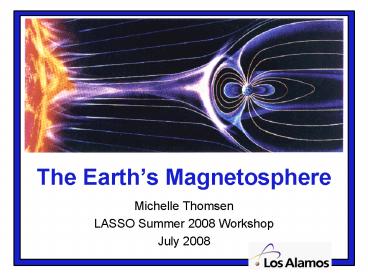The Earths Magnetosphere - PowerPoint PPT Presentation
1 / 45
Title:
The Earths Magnetosphere
Description:
Solar wind plasma and magnetic field are excluded from the bubble. ... Separatrix. The Ring Current. Current = Moving Charge. J (electric current) ... – PowerPoint PPT presentation
Number of Views:795
Avg rating:3.0/5.0
Title: The Earths Magnetosphere
1
The Earths Magnetosphere
- Michelle Thomsen
- LASSO Summer 2008 Workshop
- July 2008
2
The Earth is a Giant Magnet
3
Immersed in theFlowing, Magnetized Solar Wind
Plasma
4
Our Magnetic Bubble The Magnetosphere
Solar wind plasma and magnetic field are excluded
from the bubble.
5
Our Magnetic Bubble The Magnetosphere
Blunt on sunward (day) side
Long extended tail on antisunward (night) side
6
Important Boundaries
shocked solar wind
SOLAR WIND
Bow Shock
Magnetopause
shocked solar wind
7
The Bubble Isnt Empty
Charged particles (plasma and high-energy
particles) are trapped in the magnetospheric
magnetic bottle.
8
Basic Structure of the Earths Magnetosphere
- Complex
- Dynamic
- Strongly coupled
- Multiple populations
MAGNETOPAUSE
9
Magnetospheric Plasma Properties
- Plasmasphere
- density 1000 cm-3
- temperature 1 eV 1 x 104 K
- Plasma Sheet
- density 1 cm-3
- temperature 5000 eV 5 x 107 K
- Radiation Belts
- density 10-6 cm-3
- temperature 106 eV 1010 K
- For comparison Earths surface
- density 2.4 x 1019 cm-3
- temperature 0.0025 eV 290 K
10
Magnetospheric Parameters
11
The Story of the MagnetosphereSourcesTranspo
rtEnergizationLossesDynamics
12
SourcesThe Solar Wind(How? is actively
debated.)andThe Earths Upper
Atmosphere(Relative importance is actively
debated.)
13
TransportPlasma Circulation in the Magnetosphere
1. Sunward Convection (driven by solar wind
blowing past)
(Equatorial Plane)
14
Like Flow Behind a Cylinder
Wake-filling flow toward object
15
TransportPlasma Circulation in the Magnetosphere
2. Corotation (caused by drag of upper atmosphere)
16
TransportPlasma Circulation in the Magnetosphere
1. Sunward Convection
Net flow
2. Corotation
17
TransportPlasma Circulation in the Magnetosphere
Open flow paths
Net flow
Closed flow paths
Geosynchronous orbit
18
EnergizationOne of the most mysterious andand
important aspects of the magnetosphere!
Radiation Belts
Source Energies Solar wind 1000 eV Ionosphere
few eV
Ring Current
Plasma Sheet
Magnetospheric Energies Plasma sheet 10,000
eV Radiation belts millions of eV
Temperature (K)
Solar Wind
Plasmasphere
Neutral gas at Earth's surface
Density (cm-3)
19
LossesWhat becomes of all that material
entering the magnetosphere?
Flow out to solar wind across dayside magnetopause
20
LossesWhat becomes of all that material
entering the magnetosphere?
Charge-exchange with residual neutral atmosphere
Cold neutral atom
Cold ion (trapped)
Energetic ion (magnetically trapped)
Energetic neutral atom (escapes)
21
LossesWhat becomes of all that material
entering the magnetosphere?
Precipitation along field lines into atmosphere
gt Aurorae
22
DynamicsMost fascinating aspect of all!
10
IMF Bz (nT)
20-30 min
0
-10
The magnetosphere responds strongly to time
variations in the solar wind properties.
23
Dynamics
Quiet
Storm
24
How do these factors combine to produce observed
magnetospheric structure and activity?
SourcesTransportEnergizationLossesDyna
mics
Take a closer look...
25
Solar Wind Interaction With the
MagnetosphereCirculation of plasma (and
magnetic flux)
Dayside Magnetic Reconnection
Night-side Magnetic Reconnection
Solar Wind
Southward IMF
convection
26
Solar Wind Interaction With the
MagnetosphereCirculation of plasma (and flux
tubes)
Features Creates cells (open vs closed
topology) Allows capture of solar wind
material Drives transport (wake filling) Allows
loss of material to balance capture Converts s.w.
flow energy to thermal energy Leads to
substorms...
27
Unbalanced reconnection (more at the magnetopause
than in the tail) loads energy into the tail and
causes it to be more and more stretched. This
strong stretching leads to the onset of new
reconnection deep inside the nightside plasma
sheet A substorm onset.
Hones, 1979
28
Substorms Particle Injections, and Aurorae
29
What are the consequences of the global transport
pattern ionospheric outflow?
- Closed drift paths gt flux tubes can circulate
- many times around the Earth.
- Long exposure to ionospheric outflow gt flux
- tubes fill with cold plasma gt Plasmasphere
30
The Plasmasphere
31
The size of the plasmasphere varies with the
strength of the global convection.
Strong
Moderate
Weak
32
What are the consequences of the global transport
pattern solar wind entry?
Open drift paths deliver newly-captured solar
wind plasma (the plasma sheet) deep into the
magnetosphere.
33
What happens to the plasma sheet material?
- Drifts through to dayside magnetopause
- Precipitates into the atmosphere -gt Aurorae
- Charge exchanges with cold, neutral exosphere
- -gt loss as energetic neutral atoms
- Gets trapped and energized -gt Ring Current and
Radiation Belts
34
Energy-Dependent Drifts
Convection
Gradient/Curvature Drift
35
Ion Drifts in the Magnetosphere
Separatrix
36
The Ring Current
Current Moving Charge
J (electric current)
37
Effect of the Ring Current Magnetic Field
Perturbations
38
Ground Magnetic Perturbationsfrom the Ring
Current
(Compare to dipole field strength at equator
3.5x104 nT)
39
Magnetospheric Dynamics Storms
IMF is very strongly southward for an extended
period
which drives very strong magnetospheric
convection
40
Storm-Time Ring Current
41
Stormtime at Geosynchronous Orbit
Quiet
Storm
42
Storm-Associated Radiation Belt Enhancements
43
Radiation Belt Variability
From Li et al., 1997
44
Magnetospheric DynamicsSo What?
Tune in Friday (Space Weather)!!
45
The Magnetosphere A Busy Place!

